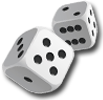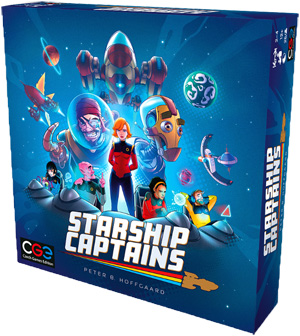



play board games
Board game reviews, strategy tips & session reports
Starship Captains Board Game Review
 Stats:
Stats:
No. of players: 1-4
Amount of time to play: 40-100 min (depending on player count)
Age requirements: 12+
Set-up time: 5-10 min
Starship Captains is a medium-light board game that combines familiar mechanics in a unique way. Can you score the most VPs and be rated the best captain in the fleet?
Starship Captains Rules Description:
Starship Captains has a Star Trek based, sci-fi theme. Just looking at the cover evokes images from the famous series. In this board game you play a newly minted captain and must fly around the board completing missions with your crew. But be aware some routes contain pirates that will damage your ship.
On your turn you place an ensign on a room to activate it, use artifacts to activate a room, or pass. Once you pass you are out of the round and once before your turn you may promote an ensign.
Your starting crew consists of two red, blue, and yellow ensigns and one gray cadet. Your ship has four rooms to activate that correspond to your crews’ colors. Each room, with the exception of the gray one, may only be activated by an ensign that matches its color.
The yellow room lets you shoot down adjacent pirates, but you’ll take one damage. Eliminating pirates gets you bonus resources, makes it safer to travel, and each pirate you shoot down and store on your spaceship is worth one VP at the game’s end.
Activating the red room lets you move up to two spots on the board. If you move through a pirate, you take one damage. If you are at a location with a mission, you can complete it by assigning ensigns to it. Missions take one to three ensigns to complete and using matching colored ensigns will get you extra resources (and sometimes damage). You must use androids if they are shown on the mission card. Completed missions score you VPs. A few of the locations have space stations on them. Stopping at them grants you a bonus and gains you favor with that faction. Each faction has a track you move around and hitting certain milestones will get you extra resources and VPs at the end of the game.
Tech is gained via the blue room. The cards are placed on your tech board and give you bonuses, additional rooms to activate, or additional ways to score VPs. The edge of these cards have symbols and when you match them you instantly get a bonus based on the matched symbols. Each game has three random omega-tech cards you may acquire. These provide end of game scoring.
Lastly, the gray room repairs your ship. This opens up space for storage and additional tech cards. At the start of the game your ship is a bit damaged so you will probably need to fix it at some point.
As they are used, whether in rooms or missions, ensigns go into the queue on the top of your board. At the start of a new round all but the last three ensigns return to your ready room.
Another resource in Starship Captains is medals that are used to promote your crew. Gray cadets and ensigns may be changed to another colored ensign for one medal. And you can promote your other ensigns to commanders. Commanders are able to take two actions. In addition to activating rooms, they can bring a matching ensign back to the ready room from the crew. So they can activate two rooms (or the same room twice) that match their color or activate a room and bring an ensign back to the ready room. Commanders assigned to matching missions get the bonus twice.
Your ship can also hold artifacts. Artifact tokens are split into two colored halves and on your turn you may combine two matching halves to activate a room matching that color.
Between rounds you’ll get some resources and even new cadets, but after four rounds the game ends. You gain VPs for completed missions, omega-tech cards, your place on the three faction tracks, commanders, pirates and other resources on your ship. Then you subtract a VP for each damage your ship still has on it to get your final score. The player with the most VPs wins and tied players share the win.
Quick Review of Starship Captains:
Starship Captains is a medium-light board game that is great for those newer to hobby gaming or those that love the Star Trek theme. Experienced gamers use it as a next-step board game for those that have tried many or the gateway games out there and are ready for a bit more weight.
The components for this game are great and help exude the theme. Just looking at the cover art and reading the flavor texts reveal its Star Trek vibe. On the table the board is full of color and the pieces and player boards are attractive and functional. The rulebook is well-written and this video is fantastic for learning the game. My one complaint is the cardboard spaceship player tokens. They are annoying to put together and miniatures would have been much better.
Categorizing Starship Captains is difficult. It has many familiar mechanics like action selection, resource management, and a dash of set collection. But they are put together in a way that feels unique from other games. It almost feels like there is a pick-up and deliver aspect to the game, but it is more about getting around the board.
There is a certain satisfaction when you complete a mission or perfectly use your crew to take out some pirates, move to a location, and get set up for the next round. Delighting in the efficiency of your plan and actions is fun. But you might be frustrated when others get your target location first and re-planning causes inefficiency.
The rulebook has an epilogue where you can look up your score. It has some funny text to help you know just how well (or poorly) you did. It fits the theme and can bring a few laughs to the table even if you did not perform that well.
I enjoy Starship Captains but wish it had more depth. It is what it is and after a handful of games you will probably see most everything it has to offer. And as stated above I think newer gamers will enjoy this more than those that have been in the hobby a while. But if you enjoy the theme and have newer gamers often joining your group, you should pick this board game up.
Score and synopsis: (Click here for an explanation of these review categories.)
Strategy 3 out of 6
Luck 3 out of 6
Player Interaction 4 of 6
Replay Value 4 out of 6
Complexity 2 out of 6
Fun 4 out of 6
Overall 4 out of 6

Leave a Reply